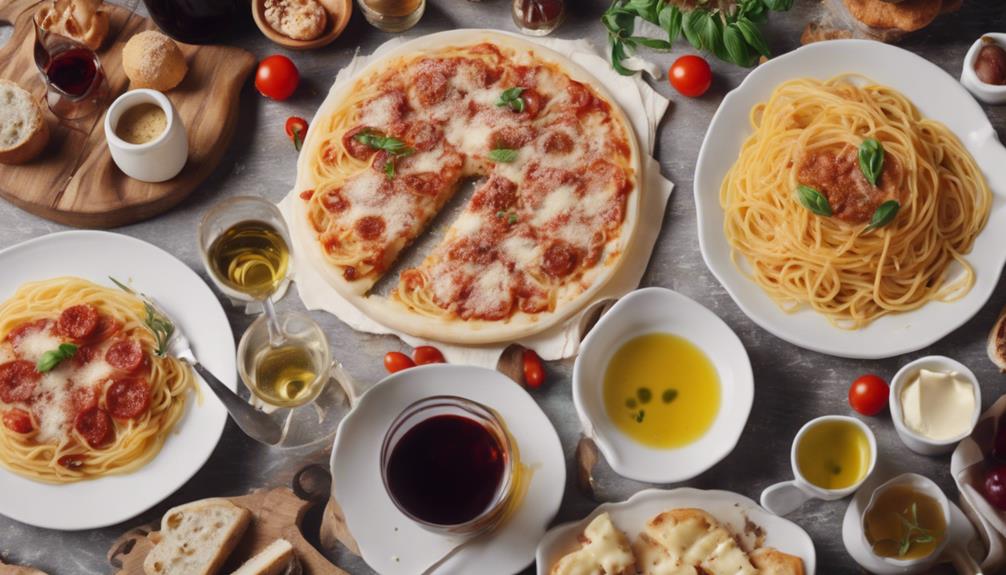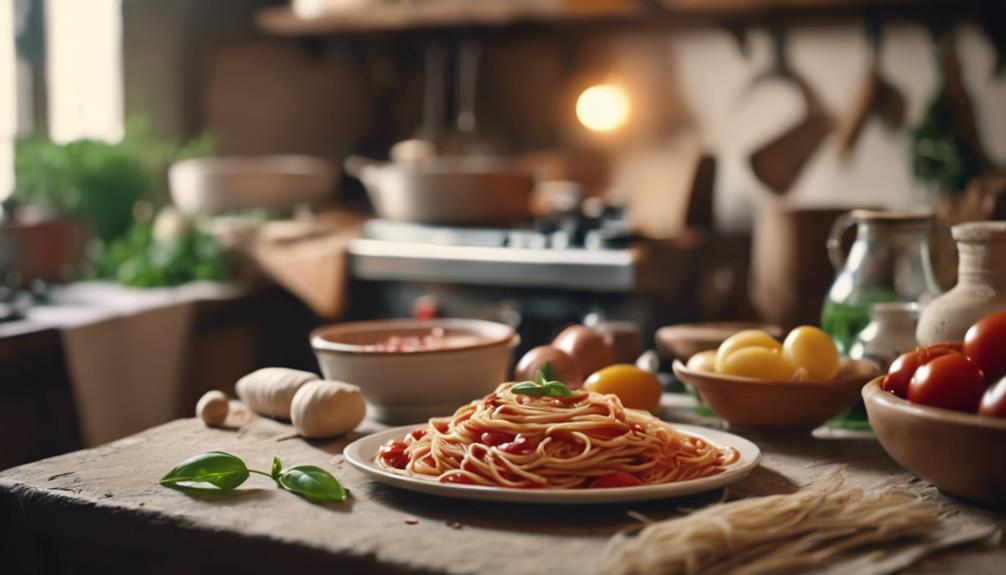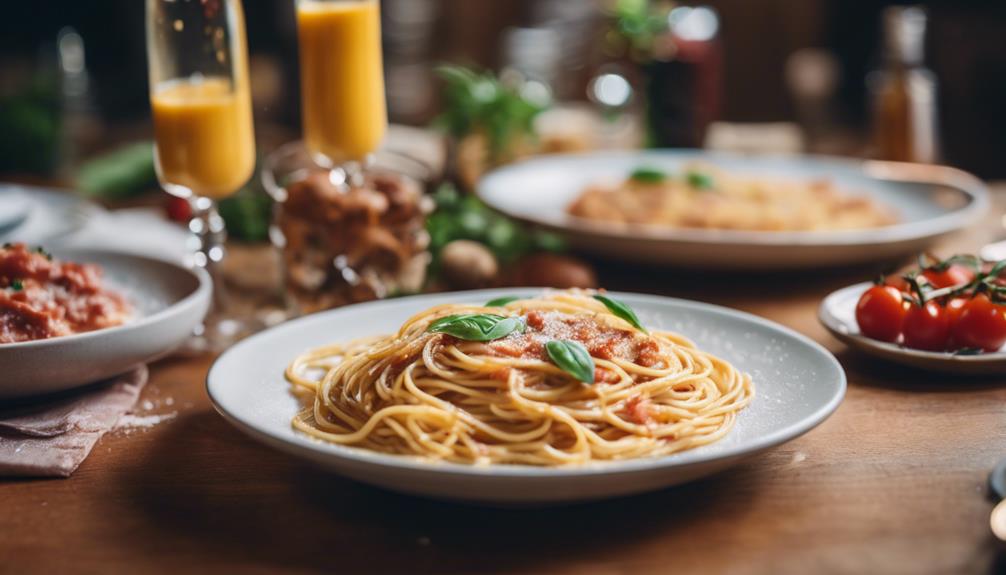When delving into the realm of Italian cuisine, get ready for an enticing journey through iconic pasta dishes like lasagne alla Bolognese and spaghetti alla carbonara. Risotto varieties offer a creamy comfort with key ingredients like Arborio rice and Parmesan cheese. Explore traditional meat delights such as vitello tonnato and pollo alla cacciatora. Finish your meal on a sweet note with classic desserts like tiramisu. The smell of regional bread specialties like focaccia will leave you yearning for more. Don’t miss out on enjoying the fried delicacies and seafood options. Vegetarian dishes and Italian cheese selections are waiting to delight your taste buds next.
Key Takeaways
- Traditional Italian pasta dishes like lasagne alla Bolognese and spaghetti carbonara.
- Risotto varieties with Arborio rice, butter, and Parmesan cheese.
- Classic Italian meat dishes such as Vitello Tonnato and Pollo alla Cacciatora.
- Iconic Italian desserts like tiramisù and cannoli.
- Regional bread specialties like focaccia and arancini showcasing diverse flavors.
Pasta Dishes
Italian pasta dishes, a culinary delight originating in Sicily, have become a beloved staple in Italian cuisine. Traditional Italian pasta is typically made from durum wheat, water, and eggs, offering a versatile base that pairs perfectly with various sauces and toppings.
From the rich and savory meat sauce in lasagne alla Bolognese to the creamy and indulgent spaghetti alla carbonara, Italian pasta dishes cater to a wide range of tastes and preferences. If you're a fan of seafood, the flavorful spaghetti vongole with clams is a must-try.
The beauty of pasta lies in its ability to adapt to different flavors and ingredients, making it a favorite choice for many around the world. Whether you prefer a classic tomato-based sauce or a more adventurous seafood twist, there's a pasta dish for every palate.
Risotto Varieties
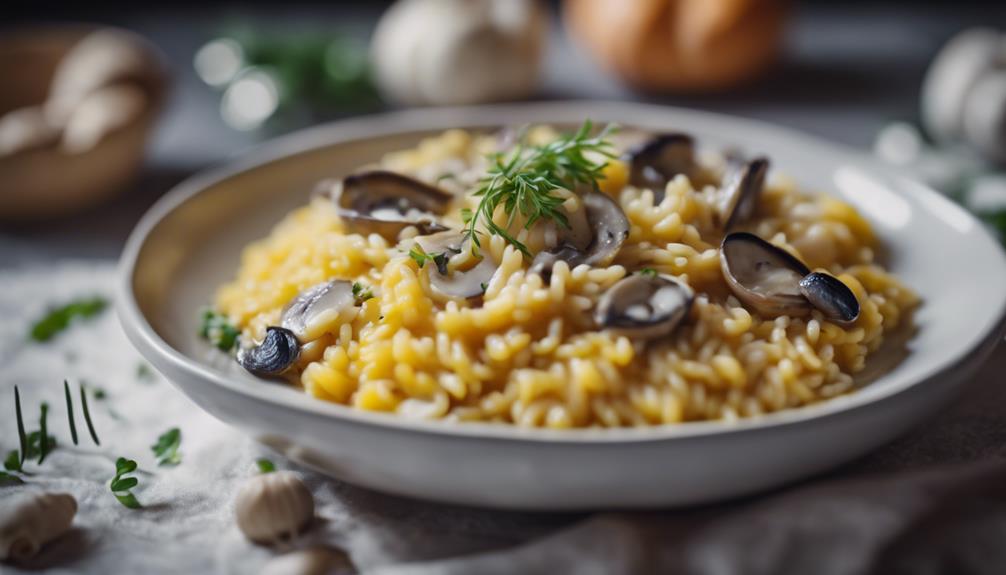
Let's talk about risotto varieties – a creamy and comforting Northern Italian dish that's perfect for any occasion.
Classic risotto recipes are a must-try, featuring ingredients like sautéed onion, carrots, and a generous sprinkle of Parmesan cheese.
Learning the art of cooking risotto properly will elevate your culinary skills to a whole new level!
Classic Risotto Recipes
Explore a variety of classic risotto recipes featuring rich and creamy textures and a burst of flavors. Originating from Northern Italy, risotto is a beloved dish made by simmering rice pasta in flavorful broth until it develops a luxurious creamy consistency.
One iconic version is Risotto alla Milanese, a vibrant dish infused with aromatic saffron, giving it a golden hue and a subtle earthy flavor. Another popular variation is Risotto ai Funghi, where the risotto is enriched with earthy mushrooms, creating a hearty and satisfying dish.
To achieve that signature creamy texture, classic risotto recipes often call for ingredients like cheese, butter, onions, and a splash of wine for added depth of flavor. The combination of these elements results in a dish that's both indulgent and comforting.
Whether you opt for a traditional recipe or decide to customize your risotto with seafood, vegetables, meats, or herbs, the versatility of risotto allows you to create a dish tailored to your preferences while still enjoying that creamy goodness that makes it a classic Italian favorite.
Ingredients for Risotto
To create a delicious risotto dish, start by selecting the right variety of rice such as Arborio, Carnaroli, or Vialone Nano to achieve that creamy and rich consistency. These rice varieties are known for their ability to absorb liquid while releasing starch, resulting in the velvety texture that's characteristic of a well-made risotto. When it comes to making risotto, the choice of rice is essential for achieving that perfect balance of creaminess and richness.
Here are some key ingredients and tips to elevate your risotto game:
- Butter: Adding a knob of butter towards the end of cooking enhances the creaminess of the dish.
- Parmesan Cheese: Grating fresh Parmesan cheese on top adds a nutty richness to the risotto.
- White Wine: Deglazing the pan with white wine before adding broth layers in depth of flavor.
- Chicken or Vegetable Broth: Using a flavorful broth is vital for infusing the rice with delicious taste.
Cooking Risotto Properly
For an authentic and delectable risotto experience, mastering the cooking process of different risotto varieties is essential. Risotto is a classic Northern Italian dish known for its creamy and rich texture, achieved through the slow absorption of broth into Arborio rice. The key to a perfect risotto lies in the technique – stir constantly to release starch, creating that velvety finish that defines a well-cooked risotto.
Whether you prefer a mushroom-infused risotto, a seafood medley, or the luxurious touch of saffron, the versatility of risotto allows for endless culinary creativity. Each variation offers a unique flavor profile, but the method remains the same – patience, attention, and a good wooden spoon for stirring.
Traditional Meat Dishes

Traditional meat dishes in Italy offer a rich tapestry of flavors and culinary heritage, showcasing the diverse regional influences on Italian cuisine. From delicate veal dishes to hearty chicken stews, Italian meat-based recipes are a true delight for the taste buds.
Here are some traditional meat dishes that you must try:
- Vitello Tonnato: This unique dish combines tender veal with a creamy tuna sauce, creating a flavor explosion that's both surprising and delightful.
- Pollo alla Cacciatora: Originating from Tuscany, this classic chicken stew is a comforting blend of olive oil, tomatoes, and red wine, perfect for a cozy evening meal.
- Costoletta alla Milanese: Dating back centuries, this Milanese favorite features a veal cutlet coated in crispy breadcrumbs and fried to perfection.
- Italian-American Cuisine: Explore adaptations of traditional Italian meat dishes in Italian-American cuisine, such as the famous Chicken Parmesan, where poultry is the star of the show.
These dishes not only highlight the culinary prowess of Italian chefs but also reflect the rich history and diversity of Italian gastronomy.
Classic Desserts

Classic Italian desserts are a delightful way to end a meal, satisfying your sweet tooth with iconic sweets that have stood the test of time.
From the creamy layers of tiramisù to the crispy cannoli filled with ricotta cheese, these traditional dessert recipes are sure to transport you to the heart of Italy with each decadent bite.
Get ready to indulge in a world of rich flavors and textures that have become beloved staples in Italian cuisine.
Iconic Italian Sweets
Indulge in the decadent world of iconic Italian sweets, where flavors and textures intertwine to create delightful classic desserts. Let's take a journey through some of Italy's most beloved sweet treats:
- Tiramisù: Originating from the Veneto region, this Italian dessert is a heavenly combination of cocoa and coffee flavors layered with delicate ladyfingers and creamy mascarpone cheese.
- Panna Cotta: A velvety smooth dessert made with cream, sugar, and gelatin, offering a simple yet luxurious flavor profile that melts in your mouth with each spoonful.
- Gelato: Italy's famous frozen dessert, gelato is a creamier and denser version of ice cream, coming in a myriad of flavors that range from fruity sorbets to rich chocolate blends.
- Cannoli: These crispy pastry tubes filled with sweet ricotta cheese are a delightful Sicilian treat, often adorned with pistachios or chocolate chips for that extra crunch.
Satisfy your sweet tooth with these iconic Italian desserts that promise to transport your taste buds to the heart of Italy.
Traditional Dessert Recipes
Explore the art of crafting these timeless Italian dessert recipes that have been passed down through generations, each one embodying the rich culinary heritage of Italy.
Tiramisu, originating from the Veneto region, is a luscious treat with layers of coffee-soaked biscuits and velvety mascarpone.
Pannacotta, a favorite among many, offers a delicate and creamy texture flavored with golden sugar and set with gelatin, creating a dessert that simply melts in your mouth.
When it comes to frozen delights, nothing beats Gelato. This traditional Italian frozen dessert stands out for its richness and variety of flavors, making it a go-to treat for any sweet tooth.
Cannoli, hailing from Sicily, are iconic pastries filled with sweet ricotta and often topped with pistachios or chocolate chips, offering a crunchy and creamy experience in every bite.
And let's not forget Zabaione, a classic Italian dessert made from eggs, sugar, and Marsala wine, resulting in a light and fluffy custard-like delight enjoyed all over Italy.
Regional Bread Specialties
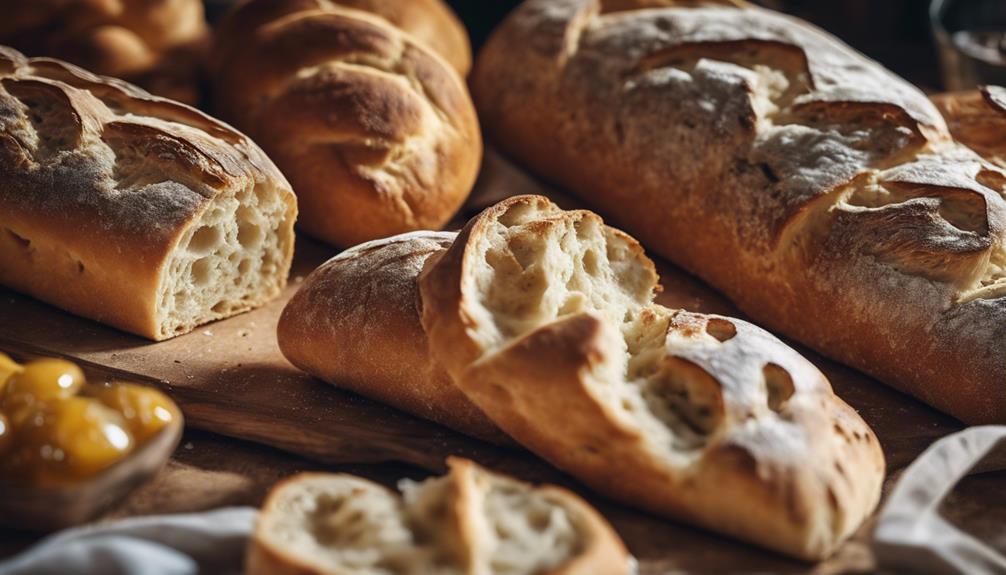
Regional Bread Specialties in Italy offer a delightful array of flavors and textures that reflect the diverse culinary traditions across different regions. From the crispy perfection of Sicilian arancini to the surprise mozzarella center of Roman supplì, these bread specialties are a tribute to the rich tapestry of Italian cuisine. Here are some fascinating tidbits about these regional delights:
- Focaccia, originating from Liguria and Sardinia, demands quality ingredients and skilled preparation techniques, resulting in a savory treat loved by many.
- Traditional Italian arancini and supplì are fried rice balls that have captured the hearts and palates of Sicilians and Romans with their unique flavors and textures.
- These bread specialties like focaccia not only offer a variety of flavors and toppings but also showcase the regional influences that have shaped Italian culinary traditions.
- Arancini, a Sicilian specialty, aren't just rice balls; they're little bundles of joy filled with meat sauce, peas, and cheese, then fried to crispy perfection.
Fried Delicacies
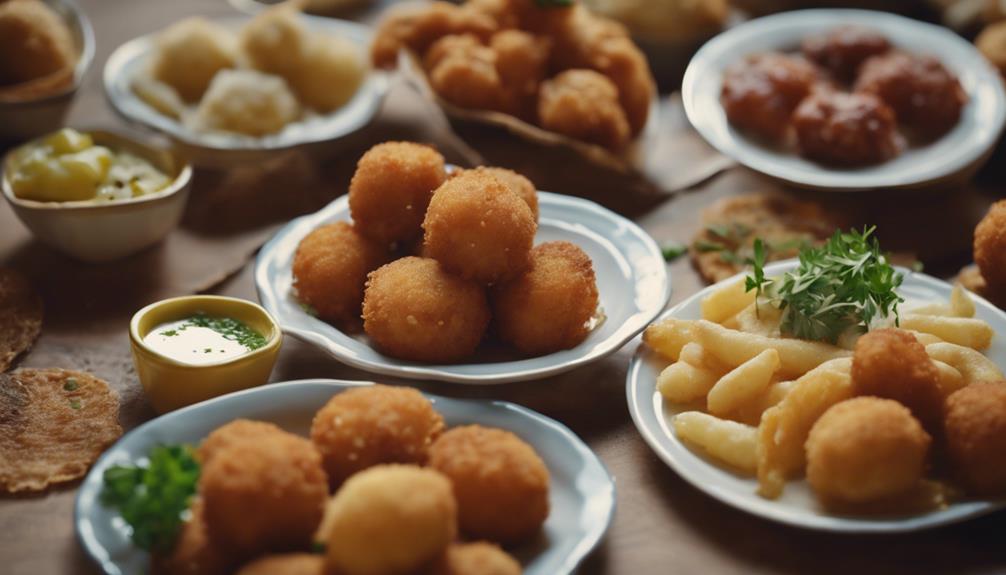
Italian Fried Delicacies offer a tantalizing array of crispy and flavorful treats that showcase the diverse culinary traditions found throughout Italy. Starting with the Sicilian favorite, arancini, these delightful rice balls are filled with a savory mix of meat sauce, peas, and cheese, creating a burst of flavors with every bite.
If you're craving something more doughy, the panzerotto fritto is a must-try. This crescent-shaped delight is filled with gooey mozzarella and tangy tomato, making it a perfect on-the-go snack.
For a unique twist, try the olive ascolane from the Marche region. These large olives stuffed with seasoned meat are fried to crispy perfection, offering a delightful contrast of textures.
If you find yourself in Venice, don't miss out on sardine in saor, where fried sardines are elevated with a touch of vinegar for a burst of freshness.
And for meat lovers, the arrosticini from Abruzzo are a true delight – skewered lamb meat grilled to perfection, offering a satisfying crunch with every bite.
Seafood Options
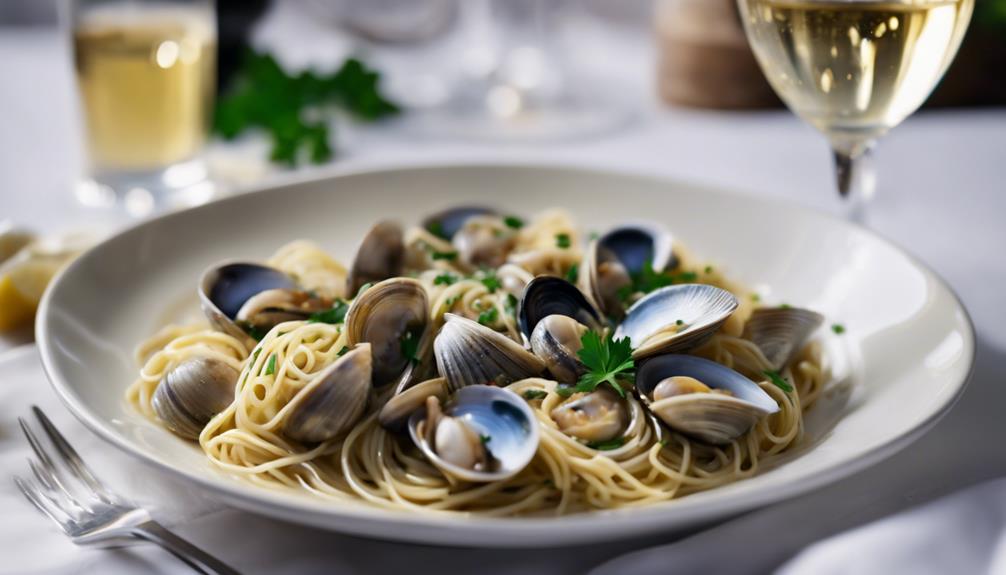
Seafood takes center stage in Italian cuisine, featuring a variety of popular options such as shrimp, mussels, sardines, squid, and cod. When it comes to Italian-American dishes, seafood plays a significant role, especially during festive occasions like Christmas Eve. Here are some reasons why seafood dishes are a must-try in Italian cuisine:
- Delicious Flavor: The freshness of seafood combined with Italian herbs and spices creates a burst of flavors in every bite.
- Rich Culinary Tradition: Seafood dishes in Italy have been passed down through generations, showcasing the country's deep-rooted culinary heritage.
- Coastal Influences: Italy's extensive coastline has heavily influenced its cuisine, resulting in a wide array of seafood options in traditional dishes.
- Versatility: From hearty seafood stews to delicate seafood pastas, Italian cuisine offers a diverse range of seafood preparations to suit every palate.
Embrace the ocean's bounty with these delectable seafood choices that embody the essence of Italian cooking.
Vegetarian Italian Dishes
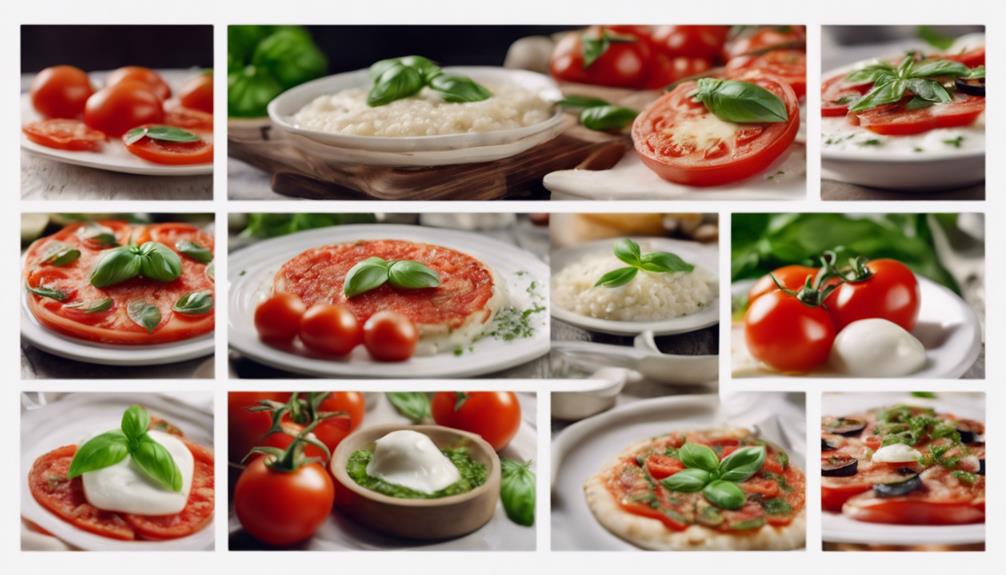
Explore the vibrant world of vegetarian options in Italian cuisine, where fresh vegetables, cheeses, and herbs take center stage in a variety of beloved dishes. From the classic Eggplant Parmesan to the invigorating Caprese Salad, vegetarian Italian dishes offer a delicious array of flavors. Feast your eyes on the table below showcasing some popular vegetarian Italian dishes:
| Vegetarian Italian Dishes | Description |
|---|---|
| Eggplant Parmesan | Breaded eggplant slices layered with marinara sauce and cheese. |
| Caprese Salad | Fresh tomatoes, mozzarella, basil, olive oil, and balsamic glaze. |
| Margherita Pizza | Simple yet flavorful pizza with tomatoes, mozzarella, and basil. |
| Risotto Primavera | Creamy risotto with a mix of seasonal vegetables like peas and asparagus. |
Whether you're craving a hearty Pasta Aglio e Olio, a comforting bowl of Minestrone Soup, or a flavorful Risotto Primavera, vegetarian Italian dishes are a delightful way to savor the essence of Italian cuisine without meat. Buon appetito!
Italian Cheese Selections
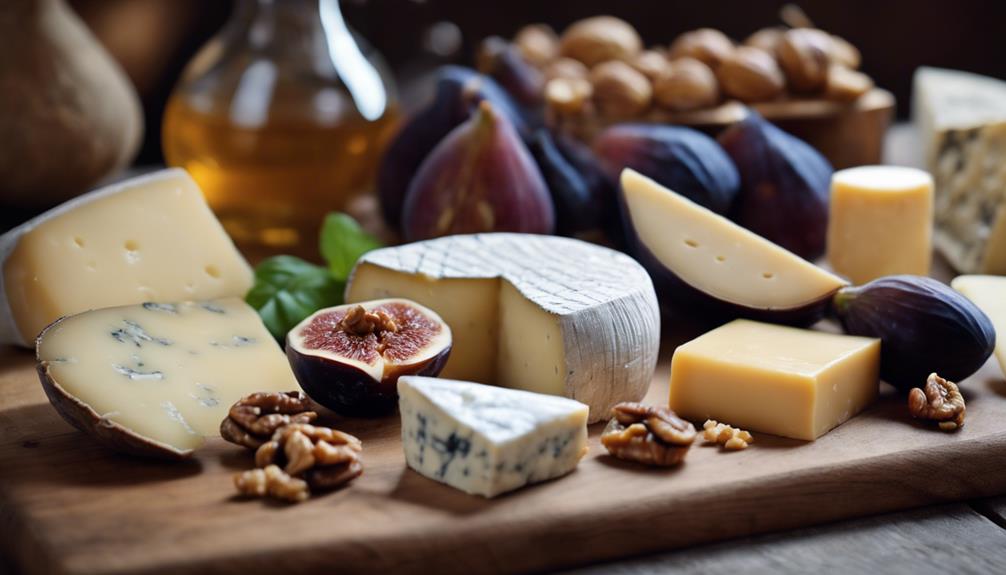
Indulge in a delectable array of cheese selections from Italy, each offering a unique taste and texture that embodies the country's rich cheese-making heritage. When it comes to Italian cheeses, known as 'I formaggi,' you're in for a treat. From the famous Parmigiano Reggiano with its nutty and granular profile to the iconic Mozzarella with its smooth and creamy consistency, the range of flavors and textures is sure to impress.
- Parmigiano Reggiano: A staple in Italian cuisine, this cheese is aged to perfection, offering a rich and savory taste.
- Mozzarella: Whether melted on pizza or enjoyed fresh with tomatoes and basil, this cheese is a classic favorite for its milky flavor.
- Pecorino Romano: With its sharp and tangy notes, this cheese adds a distinctive kick to pasta dishes.
- Gorgonzola: Bold and creamy, this blue cheese is perfect for those who love a bit of pungent flavor in their cheese selections.
These Italian cheeses not only stand out on their own but also elevate any dish they're part of, making them a must-try for cheese enthusiasts.
Frequently Asked Questions
What Are the 10 Most Popular Italian Dishes?
When you think about the 10 most popular Italian dishes, consider classics like Pizza Margherita, Lasagne alla Bolognese, Fettuccine al Pomodoro, Gnocchi di Patate, and Vitello Tonnato. These flavorful meals showcase Italy's rich culinary heritage.
What Is Italy's Most Common Dish?
You can't go wrong with pasta in Italy—it's practically the national anthem of food! From spaghetti to ravioli, there's a shape for every mood. So twirl that fork and savor the taste!
What Are 3 Famous Foods From Italy?
When it comes to Italy's culinary wonders, three must-try dishes include the iconic pizza from Naples, creamy risotto from the north, and the delectable tiramisù dessert hailing from the Veneto region. Buon appetito!
What Are Some Classic Italian Dishes?
When exploring classic Italian dishes, consider the rich diversity of flavors and origins. From creamy risotto to comforting lasagna, each dish tells a story of Italy's culinary heritage. Immerse yourself in the world of Italian cuisine!
Can you provide some simple Italian dishes that are easy to make at home?
Sure! Some easy Italian dishes suggestions to make at home include classic spaghetti aglio e olio, crispy pizza Margherita, and creamy risotto with mushrooms. These dishes are simple to prepare and require minimal ingredients, perfect for a quick and delicious meal.
Conclusion
To sum up, Italian cuisine presents a rich tapestry of flavors and culinary traditions that have stood the test of time.
From hearty pasta dishes to delicate seafood options, there's something for everyone to enjoy.
So, why not grab a fork and indulge in the delicious symphony of tastes that Italy has to offer?
As they say, when in Rome (or at your favorite Italian restaurant), eat like the Italians do!
